Philadelphia
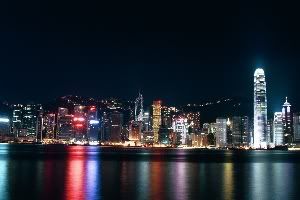
| |
|---|---|
| Motto Philadelphia, Where the World Comes Alive | |
| Population | 52,745,103 |
| Area | 18,202 km² |
| Population Density | 2,897.76 people/km² |
| District(s) | Aberdeen Charleston |
| County | Aberdeen |
| Province | Oceania |
| Country | United Kingdom |
| Post Town | Philadelphia |
| Postal Code | PH, PE, PW, AB, CK, DO |
| Parliament District | Aberdeen Charleston |
Philadelphia is largest city and the capital of the Province of Oceania, and the second-largest in the United Kingdom with a population of over 52 million in the immediate environs, and 87 million including the surrounding metropolitan area. Once the so-called capital of the American colony in the United Kingdom, the city has become one of the UK’s leading financial and cultural centres that is blossoming into a truly world city.
Ranked as the No. 1 “Most Livable City in the United Kingdom” in the 2005 edition of the annual Urban Review, Philadelphia enjoys a temperate climate, white sand beaches and a coastline that glitters with glass and gold.
Contents
History
Founded by American Norman Baker in 1820 at the mouth of the River Cerisa, which Baker originally named after himself, the city began its comparatively modest history as a layover point for trans-Pacific passages – albeit a well-known port due to its favourable climate.
The original settlement made use of the hills on the eastern bank of the Cerisa to provide a defensible position against not just envious European colonies but the native populations who, despite their power being centered much further west, would raid the colonial cities such as Georgetown (now Imperium) and St. Brendans (now Breningrad) for food, money, and weapons.
By the start of the 20th century, the city had reached nearly two million residents and the western shore with its large swaths of open land had invited the development of new industrial and manufacturing centres – although not to the same level as witnessed to the north in the British-controlled St. Brendans.
The 20th century witnessed the great growth of the city into the world city it has become. Although the Pacific had witnessed an expansion of the European empires the isolated position of the archipelago left the colonial city of Philadelphia neglected by the United States government, and so in 1905 Baker withdrew the city and the colony from the Union and hoisted the flag of Great Britain in place of Old Glory. In modern times it has become evident that the then governor of the British colony, Sir Nigel Moore authorized the transfer of a significant amount of cash to Baker for the transfer of allegiance – an act that went without significant protest from the United States, far more interested in maintaining its grasp on Latin America than a far-flung and difficult to reach Pacific colony.
Under the rule of the British the city was opened to the British market and was given a new lease on life. Although most industrial focus had long since passed the city, entrepreneurs saw the opportunity to make money with the city as a banking and commercial centre for the whole of the island chain. With the Treaty of Georgetown (1907), which approved a free-trade economic zone for the whole of the archipelago, the city of Philadelphia began to see rapid growth in its financial sector as the prior limitations and constraints on trade between the various colonies were abolished.
In 1910 the city annexed all the territory just south of the community of South Bend to the coast of New Australia. Although this move would put the city into financial difficulties for nearly the next thirty years it allowed the city to take a single approach to unifying the various transit and infrastructure systems sprouting up in the immediate environs of the city. Some attribute the current city’s efficient transit system with this annexation and the uniform improvement plans which followed.
With the rest of the archipelago, the city achieved full independence from the British crown in 1912. Throughout the coming years leading up to World War I, Philadelphia businesses invested in developing numerous private ventures that would benefit the city in years to come, one being the first underwater telegram cable that reached the western coast of the United States and from there the rest of the world.
Geography
Physical Geography
Philadelphia sits astride the east and west bank of the River Cerisa in the Province of Oceania on the island of New Australia in the Azazian Archipelago. As the river empties into the Pacific Ocean it discharges approximately 2,400 m³/s and so flows rather slowly, an advantage that renders the massive harbour and bay of Philadelphia silted at a rate that can be dealt with modern dredging technology.
To the east of the city lay the Oceania Range, formed by the collision of the Belden Continental Plate into the Azazian Plate, the former laying to the east of the Brittany Strait while Philadelphia lay upon the Azazian Plate with the Oceania Range. The foothills of the Oceania Range extend almost the length of the New Australian Coast until they reach the River Cerisa, where they wind down to flat plains that stretch from the river on into the central and western regions of the island. For Philadelphia, this creates a narrow stretch of land along the eastern bank of the river while to the west lay kilometers of open land. It is the eastern bank where most of the city’s high-end services are located and the western bank where most of the city’s population resides.
Climate
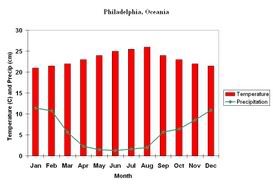 Climograph of Philadelphia |
|---|
The Philadelphia region falls under the designation of a tropical wet and dry climate according to the Köppen Climate Classification System. Temperatures remain relatively constant, hovering between 25 and 30 degrees Celsius while precipitation comes in a wet and a dry season with the most precipitation falling in the winter months near January while the months of June, July, and August often sees under 2 centimeters of precipitation.
Precipitation does occur nearly everyday, however, as the climate is governed by a Pacific anticyclone, a subtropical high-pressure system that generates relatively stable weather blown in from the prevailing trade winds that run from the northeast to the southwest. Although the high pressure systems carry little water, the fact that it exists over the warm Pacific north of the Azazian Archipelago means that these winds do carry some precipitation, an amount sufficient enough to ensure that the Philadelphia region receives light, and brief, rain showers almost everyday. A side effect of this is that the skies above Philadelphia, while often free of rain clouds, are almost never cloud-free although they remain a vibrant blue.
During the winter months, however, as the subtropical high moves to the south, the influence of low-pressure systems and accompanying cold fronts can bring major storm systems across the archipelago, most often from west to east or southwest to northeast – and with Philadelphia located to the windward side of the Oceania Range the precipitation is increased through the orthographic process. It is these winter months that see the most severe weather in Philadelphia, although even in these storm systems lightening and thunder are often infrequent and the storms consist mostly of torrential downpours and bursts of high winds.
Environmental Issues
Philadelphia leads the United Kingdom in its attempts to develop an interface between urban development and the environment that conserves and preserves the city’s natural beauty. The city makes use of an extensive network of mass-transit systems from high-speed, high-capacity light rail systems to ferries and busses, the majority of which are now powered by low-emission hybrid engines. However, the substantial size of the city’s population equates into a still significant environmental footprint in the area of air and water pollution.
The natural advantage of Philadelphia is that the prevailing trade winds push most of the air pollution away from the landmass while the Oceania Range’s windward face collects most of the pollution transported from New Britain and other islands to the north and east. Of more immediate concern, however, is the consumption of water resources.
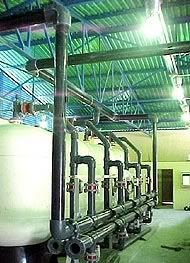 The interior of a desalinisation plant outside Philadelphia |
|---|
Although much of the city can draw from the relatively unpolluted River Cerisa, there remain millions of citizens who must pay for water imported from mountains and aquifers located throughout New Australia – requiring an expansive water transportation infrastructure system that itself leaves an environmental footprint. Urban dwellers, both businesses and denizens alike, have also attempted to make water more accessible and many newer constructions utilise rain-catchments on their roofs that feed water into the city’s main treatment system. Through the use of meters and registers, the individual owning the property who collects rainwater for the city’s use receives a proportional discount on the price of clean water he or she uses from the city’s water system.
The other solution for the water shortage are the eight massive desalinization plants along the coast of Oceania that produce enough drinking water to cover the province’s shortcomings and enough to export to the northern province of West Oceania. However, the desalinization plants produce a hypersaline brine as a byproduct of the creation of fresh water, a substance that must be disposed of or it can cause significant damage to especially marine environments. Indeed, a coral reef off the coast of New Australia has already lost significant portions of its natural biodiversity as a result of the careless dumping of the brine into the ocean, which carried it south and to the west to the coral reef. Since this discovery, Parliament has enacted strict measures regarding the disposal of desalinization byproducts but the effects of years of misuse will remain for decades to come.
Government
The city of Philadelphia is divided into six districts for both local, regional, and national elections. However, for local politics, i.e. the governance of the city, the districts are broken into small neighbourhoods that elect a representative to the city’s Legislative Assembly. For both regional and national representation the districts host a single representative chosen in what are often highly contentious local elections.
The Legislative Assembly drafts and passes bills to govern the city and all the land within its limits. The Assembly is a unicameral institution and follows many of the same procedures as does the UK Parliament although with noticeable changes reflecting its unicameral nature.
On election days voters also choose an individual to represent their district in the City Council. The City Council acts as an executive board, presided over by the Lord Mayor of Philadelphia, who is selected from among the six councilors upon a rotating basis (one for every six years between the election cycle.) The City Council is tasked with provided the city’s assent on legislation and with enforcing the legislation if it receives said assent.
Prior to the 1970s the two bodies were in effect one institution, but the city’s Better Government Act of 1974 split the once joint legislative-executive functions of the former City Assembly into the two separate branches that now govern the city.
Economy
 Looking Towards the Financial District |
|---|
Philadelphia is the business and commercial capital of the United Kingdom with the financial, insurance, real estate, and creative industries as the backbone of the city’s economic power. In the past, manufacturing and the mining of iron and coal once played an important role although in recent decades these industries have been on a decline.
Although the Philadelphia Exchange (PHEX) ranks second to that of the Barent Exchange it should be noted that the two exchanges feature two different sectors of the UK economy with the Barent exchange holding the nation’s primary industrial and resource-based corporations while the PHEX lists most of the UK’s service industry goods – and as the UK’s manufacturing industry continues to decline the PHEX is expected to surpass the Barent Exchange permanently within the next five years.
The financial sector of the city serves not only the whole of the United Kingdom but also functions as the UK’s primary financial interface with the world markets with many of the UK’s main internationally-focused banks and credit companies headquartered in the city. In coming years, as the UK slowly opens itself up to the international market the city can be expected to grow as a home to international businesses – especially in the financial sector.
The service industries, including science research companies and medical laboratories, have also flocked to the city because of its status as the nation’s leading internet gateway, the main terminus for many fiber-optic cable trunks connecting the United Kingdom to the rest of the world. Especially making use of this unique position are numerous software and game-design firms that utilise the excellent data-transfer rates to connect to their offices in foreign countries or even to sell their product overseas.
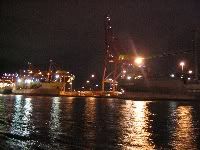 Port of Philadelphia |
|---|
The Port of Philadelphia, operated by Portus Mercaturae, remains one of the city’s most invaluable assets. As the River Cerisa empties into the Pacific Ocean, it widens rapidly and while silt does tend to build up in the deep natural channel the city frequently dredges the harbour to both keep the port at maximum capacity as well as to add land to the southern coast of the city, allowing for a slow, but continual growth of the city’s borders. The estimated total tonnage of shipping estimated to flow into the Port of Philadelphia in 2005 comes in at nearly 2.25 billion gross tons, only Breningrad comes close at 1.9 billion gross tons estimated for the year 2005.
To the north and west of the port lay the city’s many industrial zones, which although in decline in recent years, still provide the United Kingdom with millions of tons of consumer goods and most importantly specialized manufacturing especially in the areas of shipbuilding. Although headquartered in Breningrad, Breningrad Shipyards Merchant Division operates nearly thirty drydocks along the harbour for the construction of civilian merchant ships from container vessels to ultra-large oil and natural gas vessels. In a telling sign of the city’s importance in shipbuilding, although it remains second to Breningrad, the nation’s number two shipbuilder, Carson and Wolff also operates just over twenty drydocks for the construction of civilian merchant vessels and naval warships.
Demographics
As of 2005, Philadelphia has an estimated population of 52,745,103. This number is a net increase of 8.3% since 2000 when the population was officially counted at 48,666,927. The current population includes 24,899,323 households and 11,565,822 families residing in the city, roughly representative of the province of Oceania.
With its location facing the southern Pacific and the human geographic pull of high wages, plentiful employment, and a comfortable tropical climate the city welcomes millions of immigrants, most legal, each year with most coming from impoverished nations throughout the Pacific. Perhaps the largest internal population shifts within the UK are from the impoverished Russian northwest to Philadelphia and other cities that offer economic vitality and an overall better climate. In short this immigration has provided the impetus for racial shifts within the human geography of the city while certain other sections of the city have begun the process of gentrification.
And yet despite its massive population, the actual city limits of the city encompass a large amount of area and so the technical density of the city is comparatively low for a city the size of Philadelphia. But this is only technical as the city planners make use of large greenbelts in the city to keep down on pollution and to diminish the urban heat bubble and so the actual density of the city is likely quite higher than its official number.
The median income for a family living in Philadelphia falls at approximately $60,000USD while the unemployment rate falls below the national average of 2.7% at only 2.2%. The median age for the population is 33, almost proof that the city’s self-description of a young, and vibrant city is relatively apt.
Lastly, the city has continued to experience relatively low crime rates, officially released information providing the figure of 1,433 crimes per 100,000 people.
Culture
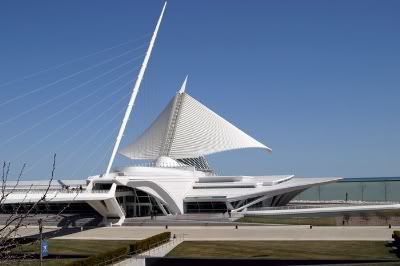 The Aaronson Museum of Modernity |
|---|
While Philadelphia is not the cultural centre of the UK the fact that much of the nation’s wealth can be found in its banks and businesses have secured the city as a financier of the arts throughout the UK. State-run museums and galleries populate the city’s historical district while numerous privately owned and operated institutions are scattered throughout the city.
The Aaronson Museum of Modernity opened in late 2005, and while on the outskirts of the city, it has proven a viable tourist attraction being linked to the city’s core and major airports by both light-rail and bus lines. Holding a significant number of art pieces from the late twentieth century, most by Azazian, European, and American artists, the Aaronson grants the UK and its visitors access to one of the most thorough galleries of modern and post-modern art.
The Caslon Symphony House, adjacent to the commercial core on the River Cerisa, provides the city’s population with easy access to orchestral performances in a state of the art facility designed to amplify and magnify the audible experience of the performances.
The city also boasts a number of sports teams from rugby and cricket to football and soccer while even hosting one of the UK’s few American football teams. And although sports teams do not compete outside the UK they remain a popular form of diversionary entertainment in either person or through televised sporting events.
Transportation and Infrastructure
Home to one of the largest inter- and intra-urban transportation systems in the United Kingdom, if not the world, the city of Philadelphia has attempted in the past several years to steadily decrease its dependence upon personal automobiles. The older sections of the city, primarily the central business district, have few areas left in which they can expand their infrastructure for automobiles, i.e. more roads, double- and triple-decked highways and so the city has implemented a plan to charge tolls on the most heavily traveled roads within the city’s most congested cores.
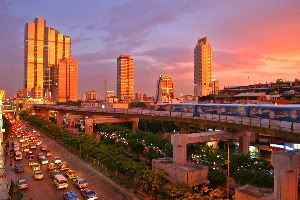 Sky-Rail Headed Towards the Aberdeen District |
|---|
According to the city’s Transportation White Paper (2003), the fares collected will help finance a major plan to re-design and re-vitalise the city’s mass transit system with higher capacity systems primarily of the light-rail variety. With nearly five hundred kilometers of light rail tracks already laid in the city, primarily underground, expansion is set to occur above city streets. The White Paper of 2003 called for the establishment of a radial system that would carry passengers into and out of the central cores of Philadelphia at an extremely fast, but safe, rate of speed.
Not all of the city’s needs, however, can be met by simple rail and road plans for as one travels south the city is slowly split ever further apart by the Bay of Philadelphia, which hosts His Majesty’s Station Philadelphia as well as the busy Port of Philadelphia. To the north of the bay near the mouth of the River Cerisa the Norman Baker Bridge, a combined railway-road bridge that utilises a self-anchored suspension design for its main span, was opened in early 2005 to replace an aging causeway that had to that time hindered the transit of larger ocean-going freighters and tankers further upriver to the heart of Philadelphia.
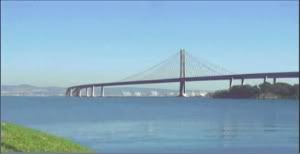 Norman Baker Bridge Crossing the Bay of Philadelphia |
|---|
Yet, the need of the Royal Navy to operate its massive warships in the bay require tunnels to be built under the sea bed in conjunction with dozens of ferry ports for cheap connections to reach the two sides of the city. In the late 1990s the city privatized the ferry companies and tunnel operators as part of Parliament’s sweeping economic reforms that sought to bring new life into stagnant industries. And while crossing the Bay still requires a significant amount of time, the new tunnels, bridges, and ferry routes greatly alleviate the prior headaches of long commuters or vacation sojourns.
Lastly, Philadelphia-based companies operate five major airports, eleven regional airports, and fourteen heliports that handle upwards of 200 million persons per year, cementing the city as the transportation hub for the eastern United Kingdom. With the enormous distances to be traveled between the Azazian Archipelago and the nearest continent, air travel has been for decades the fastest means of travel on an international level. However, with the advent of the personal plane in 2002 by the Chesterbrook Aviation Ltd., average citizens can fly cheaply on small-scale airlines that perform island hopping services to the UK’s hundreds of islands, and those without airports are made accessible by helicopter ensuring that the whole of the United Kingdom is within reach. And from Philadelphia the ability to reach the UK and the world is merged into true convenience.
Sister Cities/Twinned Cities
- Loviz, Royal Crown Colony of Novikov (formerly the independent state of Novikov)
- Timiocato, Pacitalia
- Northern Maraque City/Super City, Maraque
| Cities in the United Kingdom and Oceanic Empire |
|---|
| Global Cities Imperium | Philadelphia |
| National Cities Poldi'sk | Port Hamptonshire | Queensbury |
| Regional Cities Charlotte | Churchill | Invercardon | Kingston | Salisbury | Zvolen |
